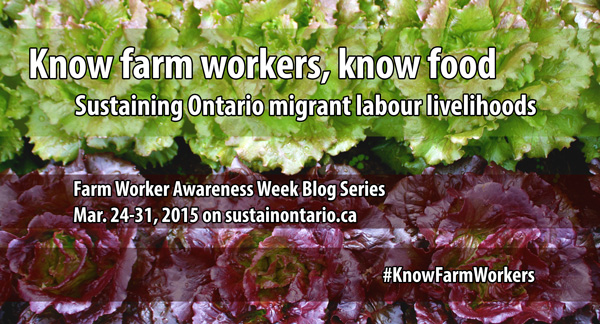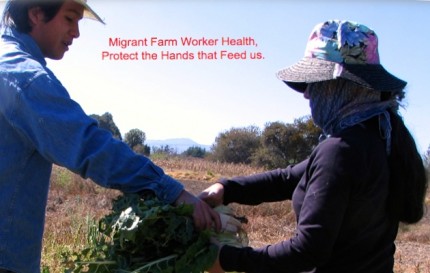‘Hot potatoes’ and migrant farm worker health
Posted: March 26, 2015
Categories: News from Sustain Ontario / Research

As part of Farmworker Awareness Week (March 24-31st, 2015), this blog series highlights some of the ideas we have gathered over the past several months on promoting healthier, more sustainable farm worker livelihoods. Check out the bottom of this post for background detail on this community research partnership between Sustain Ontario and the University of Toronto.
Fresh, local foods like peaches, tomatoes and asparagus no doubt contribute to the health of those who consume Ontario crops. In considering the health of the food system as a whole, however, Sustain Ontario was curious to learn: what is the health status of the members of Ontario’s rural communities who are hired to produce these crops?
Structural barriers to health equity
“It’s a dangerous occupation. We know that,” says Donald Cole of hired farm work in Ontario. Cole, a professor at the University of Toronto’s Dalla Lana School of Public Health has been engaged in migrant health research and advocacy with the Migrant Worker Health Project. As a sub-sector with traditionally weak health and safety oversight, agriculture involves high risks for everyone involved. However, hired migrant farm workers tend to face unique forms of vulnerability.
An emerging body of research demonstrates that the 20,000 farm workers who come to Ontario from Mexico, Central America, the Caribbean and elsewhere through Canada’s temporary farm worker program encounter considerable barriers to health equity. These include a lack of health and safety training, insufficient bathrooms and sinks in the fields, and poor availability of personal protective equipment when exposed to agrochemicals. More than 16.8% of surveyed Mexican workers encountered a work-related accident at least once during the Ontario growing season, with musculoskeletal injuries as the main outcome. Almost half of all surveyed migrant farm workers in the province indicated there were no seatbelts in their work site transportation. Although most migrants are male, female migrants in particular are at risk of sexual harassment on the job.
At the same time, and as noted earlier, agriculture is an occupation that poses hazards for everyone involved; many farm employers assume risks with their own health as well as those of workers. An anonymous representative from a provincial farm organization states that amidst the other demands of farming, farm employers in Ontario often encounter difficulty understanding and navigating the paperwork associated with labour requirements, along with occupational health and safety regulations. Ensuring these regulations are written in plain language and in short, digestible modules, says the representative, would benefit both farm employers and hired farm workers. In Ontario and other provinces, many have argued that more random spot-checks are needed to ensure compliance with existing standards of migrant farm worker housing, health, and safety. However, many farmers already feel that the regulatory burden in Ontario is too high without additional monitoring and enforcement of this kind can be challenging and costly in rural areas with widely dispersed farms.
In addition to depending on employers for worksite health, safety and housing, migrants often depend on employers for transportation and navigating the Ontario medical system. Although migrant farm workers are entitled to provincial health insurance and worker’s compensation while they are in Canada, studies indicate they face distinct barriers to health access and compensation. These include inconsistent information about their entitlements, language and cultural barriers, and long working hours (up to or more than 12 hours/day, 7 days/week during the peak season). Becoming ill or injured could mean being forced to return early to a migrant’s country of origin and missing the chance at future farm work in Canada. Between 2001 and 2011, 787 migrant farm workers were deported to their country of origin due to medical reasons. In most of these cases, farm workers were deported against their will, and some workers did not receive the health care to which they are entitled prior to repatriation. As a consequence of this threat of deportation and job loss, health and safety issues among Ontario’s seasonal agricultural workers tend to be high yet under-reported.
In a recent report, Cole and his colleagues trace each leg of migrants’ cross-border journeys, identifying policy gaps and opportunities for specific actors to step up to the plate. They indicate migrant health is a ‘hot potato’ issue wherein each relevant actor refuses to accept full responsibility for a given health issue that falls within their and others’ mandates, which often leaves migrants falling between the cracks of a jurisdictional maze.
While the Ontario Ministry of Agriculture, Food and Rural Affairs does monitor this issue to some degree, it often defers to the federal government. All of Canada’s migrant farm worker streams are administered federally through Citizenship and Immigration Canada as well as Employment and Social Development Canada. Furthermore, in Ontario a federally incorporated non-profit called Foreign Agricultural Resource Management Services (F.A.R.M.S.) has the mandate to “facilitate and coordinate the processing of requests for foreign seasonal agricultural workers.” F.A.R.M.S. is authorized by Employment and Social Development Canada (formerly Human Resources and Skills Development Canada) to fulfill an administrative function in the Seasonal Agricultural Worker Program (SAWP).
In light of these multiple levels of jurisdiction, it is perhaps no surprise that confusion often arises over which jurisdictions are responsible for a given aspect of Canada’ migrant farm worker program. Some advocates feel that the Ontario government should be playing a larger role, and that there should be more streamlined integration between all of the institutions responsible for ensuring migrant farm worker social protections. Cole asserts, “The Ontario Ministry of Agriculture and Food is virtually nowhere in this, despite their core responsibility for the food system. They just kind of aren’t at the table, which is bizarre in some ways. And that’s because it’s oriented primarily to producers and marketers, not workers. It’s not really a holistic way of thinking about it [farm worker health].”
Cole adds that from a sustainability perspective, Ontario’s Ministry of the Environment has not played as strong of a role as it could in addressing interrelated issues regarding agrochemical exposure for farm workers and environmental contamination. Stan Raper, the National Coordinator for the Agriculture Workers Alliance, which is associated with the United Food and Commercial Workers, would also like to see change in this regard. He feels there should be better coordination between the Ministry of Environment’s jurisdiction over pesticide licensing, safety and enforcement and those government branches that deal more directly with labour, such as the Ministry of Labour and the Ministry of Agriculture, Food and Rural Affairs.
Migrant farm worker health clinics

Graduate researcher Steph Mayell (second from right) at Simcoe’s Seasonal Agricultural Worker Clinic. Photo: Supplied photo.
As a complement to policy advocacy, community-driven initiatives in Ontario’s rural communities have focused on expanding local services to meet migrants’ unique health needs. Stephanie Mayell, a medical anthropology graduate student at McMaster University, has been evaluating migrant health projects made possible through Local Health Integration Network pilot funding. Kicked off in the 2014 season, the funding aimed to reduce the systemic and practical barriers to migrant farm worker health care access through community outreach, improved access to services, health promotion, and worker education. This funding helped expand the services of an existing migrant farm worker clinic in Virgil (Niagara-on-the-Lake) while bringing a new clinic to Simcoe.
Mayell argues, however, “It seems like the conditions that are causing them [farm workers employed through the temporary farm worker program] to feel a lack of dignity are the conditions of the program itself.” She observes that employer-provided on-site accommodations for farm workers often mean a lack of privacy. Other researchers have reported that because migrants’ visas are tied to their employers, it is often unfeasible to transfer to another farm if problems arise. Migrants also depend on employers for a positive evaluation in order to return to Canada the following season. Consequently, it can be difficult for them to refuse employers’ requests for long working hours, which heighten their risk of injury from occupational hazards like repetitive strain.
“A healthy workforce is a productive workforce”
Increasing a dialogue with farm employers about workers’ lived experiences could act as a starting point for improving migrant health, suggests Mayell. Ines Sousa-Batista, one of the founding members of the Norfolk Health Equity Community Committee (NHECC), echoes the importance of focusing on win-win benefits. “What’s in everybody’s interest? What’s the commonality amongst farm owners/employers and farm workers and how do we support both? Farm owners understand that a healthy workforce is a productive workforce. We should use this as an opportunity to bring farm owners/employers on board to champion this message.” The NHECC emphasizes this positive, collaborative approach when building relationships with farm employers, including the Norfolk County Agriculture Committee.
What role might Ontario’s food movement play in advancing a food system that is healthier for farm workers and viable for farmers?
Says Sousa-Batista, “I think that maybe if Sustain Ontario was in a position to look at helping to create that bridge – in a positive way – between farm workers and farm owners, that would be helpful both in the short term and the long term for farm workers.” Cole concurs that a multi-stakeholder collaborative dialogue is the “most promising approach” in addressing the ‘hot potato’ of migrant farm worker health and compensation: “I think Sustain Ontario has a chance to kind of move the agenda forward. It has a lot of political support and if they could be a convener. … If Sustain Ontario could step into the breach, actually be the linkage among all these actors; that would be great. That’s the most important thing.”
6 Key ideas from migrant health groups for Ontario’s food movement to advance migrant farm worker health equity, safety and dignity
- 1. Improve the accessibility of rural social services. In particular, the food movement can advocate for greater investment from the provincial government in rural mobile clinics as well as Community Health Clinics with Spanish-language translators/interpreters that are open during hours that coincide with workers’ schedules, and in strategic locations such as grocery stores.
- 2. Increase the visibility of farm workers in agrifood marketing. For instance, in 2013, the NHECC initiated conversations with Norfolk County officials on increasing the representation of the diverse people involved in local food production within materials that promote the region’s agriculture. Sousa-Batista says this communication was well received. She contends, “If we pride ourselves on a strong agricultural economy, then those that contribute to the agricultural foundation must become more visible within marketing/promotional materials.”
- 3. Actively celebrate migrants’ contributions to rural communities, along with their skills and expertise. Sousa-Batista proposes setting up welcome banners each season for migrants and discounts at local businesses. She also suggests farm employers could recommend migrants with decades of expertise in particular crops for collaboration in projects at the Southern Crop Protection and Food Research Centre (e.g. Vineland research project on World Crops).
- 4. Establish a network of migrant farm worker allies: Migrant farm worker advocates recommend convening a network of stakeholders across the province who are already engaged with migrant farm workers in order to collectively take action on evidence-based migrant health and related policy issues.
- 5. Facilitate dialogue with farm owners. Farm worker health equity advocates can make presentations to County Agriculture Committees regarding local farm worker resources. Farmers depend primarily on the Consulates for farm worker-related support and may not be aware of existing resources in their communities to support a healthy workforce.
- 6. Establish a standardized orientation for migrants. Along with a clear orientation to their health and safety rights, workers could receive a ‘welcome package’ including their health card. This orientation could be offered either by Canada Border Services Agency, SAWP workers’ Consulates, or a third-party non-governmental organization.
Sustain Ontario’s mission is to support food systems in Ontario that are “healthy, equitable, ecological and financially viable through collaborative action.” We recognize, however, that important gaps exist in improving equitability and financial viability for both farmers and hired farm workers, particularly for migrant farm workers. To that end, over the past several months Sustain Ontario has partnered with University of Toronto sociology doctoral student Anelyse Weiler on a service-learning project related to her research on migration, farm labour and food sovereignty. In light of the complexity of this issue, our aim is to highlight a range of perspectives in order to point toward possible actionable solutions that better meet the needs of all eaters, farmers and farm workers.
We invite all readers to participate in this ongoing conversation by commenting on the blog post series, on Sustain Ontario’s Facebook page, tweeting @SustainOntario, or emailing anelyse.weiler@mail.utoronto.ca. Feel free to use the hashtag #KnowFarmWorkers. How should Sustain Ontario take action on this issue? Please share your thoughts in the following short survey.
Create your free online surveys with SurveyMonkey , the world’s leading questionnaire tool.
2 responses to “‘Hot potatoes’ and migrant farm worker health”
Leave a Reply
You must be logged in to post a comment.


Thanks for sharing. As Canadians, we rarely think of the Health and Safety of migrant workers because many don’t consider them Canadian, yet they come to help our economy. We should definitely be more aware and take action on this very important issue.
[…] our earlier post on migrant farm worker health, we underscored how responsibilities for ensuring migrant farm worker rights and social protections […]